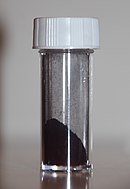Coomassie Brilliant Blue
 |
|
 |
|
| Names | |
|---|---|
| Other names
C.I. 42660, C.I. Acid Blue 83
Brilliant indocyanine 6B, Brillantindocyanin 6B Brilliant Cyanine 6B, Serva Blue R |
|
| Identifiers | |
|
3D model (Jmol)
|
|
| ECHA InfoCard | 100.025.509 |
|
PubChem CID
|
|
|
|
| Properties | |
| C45H44N3NaO7S2 (Sodium salt) | |
| Molar mass | 825.97 g/mol |
| Insoluble in cold, slightly soluble in hot (bright red blue) | |
| Solubility in ethanol | Slightly soluble |
|
Except where otherwise noted, data are given for materials in their standard state (at 25 °C [77 °F], 100 kPa).
|
|
|
|
|
| Infobox references | |
 |
|||
|
|||
| Names | |||
|---|---|---|---|
| Other names
C.I. 42655, C.I. Acid Blue 90
Brilliant indocyanine G, Brillantindocyanin G Xylene Brilliant Cyanine G, Serva Blue G |
|||
| Identifiers | |||
|
3D model (Jmol)
|
|||
| ECHA InfoCard | 100.025.509 | ||
| KEGG | |||
|
PubChem CID
|
|||
|
|||
| Properties | |||
| C47H50N3NaO7S2 (Sodium salt) | |||
| Molar mass | 856.03 g/mol | ||
| Slightly soluble in cold, soluble in hot (bright blue) | |||
| Solubility in ethanol | Soluble | ||
|
Except where otherwise noted, data are given for materials in their standard state (at 25 °C [77 °F], 100 kPa).
|
|||
| Infobox references | |||
Coomassie Brilliant Blue is the name of two similar triphenylmethane dyes that were developed for use in the textile industry but are now commonly used for staining proteins in analytical biochemistry. Coomassie Brilliant Blue G-250 differs from Coomassie Brilliant Blue R-250 by the addition of two methyl groups. The name "Coomassie" is a registered trademark of Imperial Chemical Industries.
The name Coomassie was adopted at the end of the 19th century as a trade name by the Blackley based dye manufacturer Levinstein Ltd, in marketing a range of acid wool dyes. In 1896 during the Fourth Anglo-Ashanti War, British forces had occupied the town of Coomassie (modern-day Kumasi in Ghana). In 1918 Levinstein Ltd became part of British Dyestuffs which in 1926 became part of Imperial Chemical Industries. Although ICI still owns the Coomassie trademark, the company no longer manufactures the dyes.
The blue disulfonated triphenylmethane dyes were first produced in 1913 by Max Weiler who was based in Elberfeld, Germany. Various patents were subsequently taken out on the organic synthesis.
Papers published in biochemistry journals frequently refer to these dyes simply as "Coomassie" without specifying which dye was actually used. In fact the Colour Index lists over 40 dyes with "Coomassie" in their name. There are also other Coomassie "blue" dyes. For example, the Merck Index (10th edition) lists Coomassie Blue RL (Acid Blue 92, C.I. 13390) which has a completely different structure.
The suffix "R" in the name of Coomassie Brilliant Blue R-250 is an abbreviation for Red as the blue colour of the dye has a slight reddish tint. For the "G" variant the blue colour has a more greenish tint. The "250" originally denoted the purity of the dye.
The colour of the two dyes depends on the acidity of the solution. The "G" form of the dye has been studied in detail. At a pH of less than 0 the dye has a red colour with an absorption maximum at a wavelength of 470 nm. At a pH of around 1 the dye is green with an absorption maximum at 620 nm while above pH 2 the dye is bright blue with a maximum at 595 nm. At pH 7 the dye has an extinction coefficient of 43,000 M−1cm−1.
...
Wikipedia


